| Article ID | Journal | Published Year | Pages | File Type |
|---|---|---|---|---|
| 5866682 | American Journal of Infection Control | 2015 | 5 Pages |
⢠The declination form program was compatible, flexible, easy to use, and supported by leadership.⢠Declination form program facilitators included complementary ongoing strategies and leadership engagement.⢠One-on-one attention and education at the time of vaccination led to health care worker accountability.⢠An influenza declination form program is of minimal cost, but it requires some dedicated staff and resources.⢠Vaccination rate improved from 53.5% to 77.4% pre- to postdeclination form program implementation.
BackgroundHealth care worker (HCW) vaccination rates have been low for many years (approximately 50%). Our goal was to implement an influenza declination form program (DFP) to assess feasibility, participation, HCW vaccination, and costs.MethodsThis was a prospective interventional pilot study using mixed methods to evaluate the DFP implementation processes and outcomes. We conducted a formative evaluation and interviews; data were transcribed and coded into themes. Secondary outcomes included self-reported HCW influenza vaccine uptake (pre-/postsurvey) and program costs; data were evaluated using descriptive and bivariate analyses.ResultsThe DFP was compatible with ongoing strategies and unit culture. Barriers included multiple hospital shifts and competing demands. Facilitators included complementary ongoing strategies and leadership engagement. HCW vaccination rates were higher post- versus preimplementation (77.4% vs 53.5%, PÂ =.01). To implement the DFP at site 1, using a mobile flu cart, 100% of declination forms were completed in 42.5 staff hours over <2Â months. At site 2, using a vaccination table on all staff meeting days, 49% of forms were completed in 26.5 staff hours over 4.5Â months. Average cost of staff time was $2,093 per site.ConclusionDFP implementation required limited resources and resulted in increased HCW influenza vaccine rates; this may have positive clinical implications for influenza infection control/prevention.
